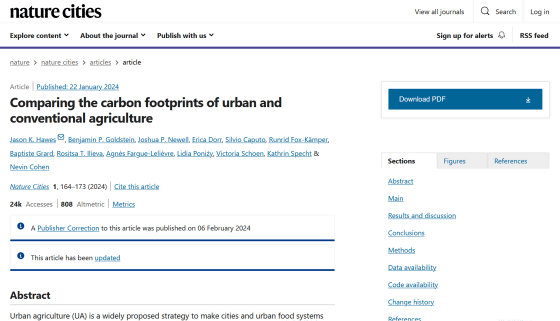Research shows that farming in urban areas is surprisingly not climate-friendly, so how can we reduce carbon emissions from urban farming?

Agriculture carried out in urban areas, such as urban areas and residential areas, is called
Comparing the carbon footprints of urban and conventional agriculture | Nature Cities
https://www.nature.com/articles/s44284-023-00023-3

Urban agriculture isn't as climate-friendly as it seems, but these best practices can transform gardens and city farms
https://theconversation.com/urban-agriculture-isnt-as-climate-friendly-as-it-seems-but-these-best-practices-can-transform-gardens-and-city-farms-221537
One of the benefits of urban agriculture is that it shortens the distance that fruits and vegetables must travel to consumers in urban areas, reducing greenhouse gas emissions from transportation. It is also expected to have the effect of alleviating the urban heat island effect, where temperatures rise in urban areas, and urban agriculture is considered an effective measure against climate change.
To find out whether urban agriculture is truly climate-friendly, a team of researchers at the University of Michigan worked with gardeners, community garden volunteers, urban farm managers, and others in 73 locations across North America and five European countries to find out whether urban agriculture is truly climate-friendly. We compared the impact of agriculture on the environment. While most research on urban agriculture focuses on high-tech projects such as rooftop greenhouses and vertical farms , this research focuses on low-tech urban agriculture found in residential backyards and communal farms. About.
The researchers modeled the carbon emissions of agricultural activities such as watering and fertilizing crops, as well as building and maintaining farms. They found that urban agriculture is on average six times more carbon-intensive when producing a serving of fruits and vegetables. We found that urban farming is not necessarily more environmentally friendly than traditional farming, even when taking into account the transport of produce from rural farms to urban areas.
The main source of carbon emissions in urban agriculture was the farm infrastructure, not the process of growing the crops themselves. Because farm infrastructure such as raised beds , equipment sheds, and concrete paths are packed into small spaces, they produce more carbon emissions per crop than traditional agriculture, which grows crops over large tracts of land. That is to say.

However, 17 of the 73 locations surveyed had lower carbon emissions than conventional farms, and the research team has summarized the points to reduce carbon emissions in urban agriculture below.
◆1: Recycle resources such as food waste and water
When building agricultural infrastructure such as raised beds and farm equipment sheds, you can reduce your carbon footprint by recycling old building materials rather than sourcing new materials. According to the research team, carbon emissions can be reduced by more than 50% by reusing building materials such as wood, cement, and glass.
Additionally, by using household food waste as compost, we can reduce the amount of fossil fuels used to manufacture synthetic fertilizers and reduce the methane produced by food waste sent to landfills. Other ways to save resources include using stored rainwater to water crops and using relatively clean sewage water.
◆2: Conventional agriculture grows crops that are highly carbon intensive
Crops such as tomatoes, which are often grown in energy-intensive greenhouses, and asparagus, which rot quickly and require aircraft to be transported, are carbon-intensive in conventional agriculture. By growing these crops in urban areas, net carbon emissions can be reduced.
The graph below shows the amount of carbon dioxide emitted when producing 1kg of Beans, Carrots, Lettuce, Onions, and Tomatoes using conventional farming (dark green). ) and urban farming (light green), urban farming has significantly higher carbon dioxide emissions for beans, carrots, lettuce, and onions, but urban farming has lower carbon dioxide emissions for tomatoes. You can see that there are few.

◆3: Maintain urban farms in the long term
Because urban environments are constantly changing, urban farms are vulnerable to development pressures. However, since infrastructure is the main source of carbon emissions in urban agriculture, continuing to manage and maintain the same urban farms over a long period of time can reduce the need for new infrastructure construction and reduce carbon emissions.
'Urban farms provide ecosystem services and social benefits, such as providing fresh food, building communities, and education,' the research team says. 'Urban farms also

◆Forum now open
A forum related to this article has been set up on the GIGAZINE official Discord server . Anyone can write freely, so please feel free to comment! If you do not have a Discord account, please create one by referring to the article explaining how to create an account!
• Discord | 'Have you ever grown crops at home? What did you grow?' | GIGAZINE
https://discord.com/channels/1037961069903216680/1209063758887129109
Related Posts:
in Science, Posted by log1h_ik







